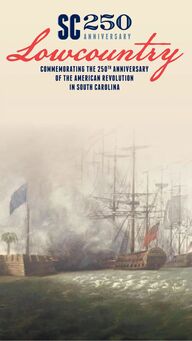
Return to flip book view
South Carolina was at the center of activity in the Southduring the American Revolution, from the earliestprotests to the last battles of the war. The prosperouscolony was home to a diverse population that wasdivided by stark economic, political, and social contrastsbetween its lowcountry and backcountry regions. Morebattles and skirmishes were fought on South Carolinasoil over the eight years of war than in any other of thethirteen colonies. The transformation of South Carolinafrom colony to state was set in motion with theestablishment of a provincial congress in 1775. Itsmembers raised military forces, wrote a stateconstitution, and sent delegates to Philadelphia for theSecond Continental Congress, where they voted to endties with Great Britain. Even before the Declaration of Independence was signed,South Carolina patriots fended off a British attempt tocapture the port city of Charleston during the battle atSullivan’s Island in June 1776. Three years later, the British launched a second campaignto take the South and successfully captured Charleston inMay 1780. With the British in control of their capital,backcountry partisans fought with renewed determinationin some of the war’s most bitter engagements. Continental and militia troops combined forces to turn thetide in their favor, winning several notable victories thatthwarted the British plan to conquer the South.**©2004 by The Society of the Cincinnati
MAP ITEstablished in 1773, its “Becoming Americans”permanent exhibit explores Charleston’s role inthe American Revolution.South Carolina’s most historic building builtin 1771, it was used by the British as amilitary prison during the war. The oldest church in town and a prominentfocal point for colonial resistance, its steeplewas used as an observation post. OLD EXCHANGE & PROVOST DUNGEONCHARLESTON MUSEUMST MICHAEL’S CHURCH & GRAVEYARDWALKABLE SITES IN DOWNTOWN CHARLESTONMAP ITMAP ITBuilt in 1772, this was the town home ofThomas Heyward, Jr., one of four SC signersof the Declaration of Independence. HEYWARD WASHINGTON HOUSEMAP ITSite of American defenses against the1780 British siege which can be viewedtoday using augmented reality. MARION SQUAREMAP ITLEARN MORELEARN MORELEARN MORELEARN MORELEARN MORE
DRAYTON HALLThis early 18th century rice plantationhouse served as a staging ground for thesiege of Charleston. FORT MOULTRIEAn early patriot victory, the Battle ofSullivan’s Island took place here inlate June 1776.HAMPTON PLANTATIONThis 18th century plantation served ashideout for Francis Marion and a refugefor women and children during the war. HOPSEWEE PLANTATIONFormerly one of the south’s major riceplantations and birthplace of Thomas Lynch Jr,a signer of the Declaration of Independence.ISAAC HAYNE BURIAL SITEGrave site of a patriot executed by theBritish military who became known as “anoble martyr in behalf of liberty.”SITES WITHIN AN HOUR DRIVE OF CHARLESTONMAP ITMAP ITMAP ITMAP ITMAP ITLEARN MORELEARN MORELEARN MORELEARN MORELEARN MORE
SITES WITHIN AN HOUR DRIVE OF CHARLESTONFORT FAIR LAWN/BERKELEY MUSEUMBIGGIN CHURCHMEPKIN ABBEYMIDDLETON PLACECOLONIAL DORCHESTERFormer colonial town that was used asan outpost by both British andAmerican forces. One of only two original Revolutionary Warfortifications in South Carolina locatedadjacent to the Berkeley Museum. America’s oldest landscaped gardensand home to Arthur Middleton,a signerof the Declaration of Independence. Current trappist monastery and formerplantation of Henry Laurens, presidentof the Contenental Congress. Originally the church of St. John’s Parish that wasburned by the British, its ruins are visible amongRevolutionary War graves and other burials. MAP ITMAP ITMAP ITMAP ITMAP ITLEARN MORELEARN MORELEARN MORELEARN MORELEARN MORE
GET LOCAL AND LEARN MORE
SUPPORTED & FUNDED BY: